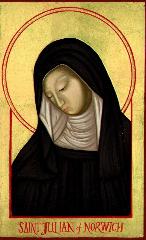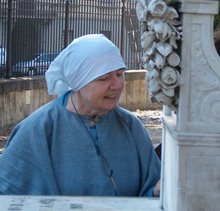Saint Umilta has come to town. She's in a glass coffin, like Sleeping Beauty, in her nun's garb, her crozier as Abbess. She rests in state at the church of San Michele e San Salvi, before going on to Faenza. Then returning to her sleepy convent in Bagni a Ripoli in the Tuscan countryside. I named our website for her, http://www.umilta.net on 'Julian of Norwich, Her Showing of Love and Its Contexts'.
Like myself, Santa Umilta was married with children, then became a nun, then fled from her convent dedicated to St Perpetua in Faenza because they teased her - she was illiterate - but could preach magnificent sermons from pretend-reading in refectory, then became an anchoress. Unlike me, she then founded an order, the Vallombrosan nuns, physically building her new convent in Florence with the aid of a donkey carrying the stones for it in panniers, raising a child from the dead, and being revered by all. Her nuns carefully preserved her sermons. She lived here in the time of Dante, dying in 1310. Above her tomb in marble porphyry hung Lorenzetti's panels of her life and miracles, and beside it, Orcagna's sculpture. Then the Medici bulldozed her convent to build their military fortress against the Florentines and her nuns fled with the tomb, the painting and the statue to San Michele in San Salvi. Then later to Bagni a Ripoli with just her body, the paintings being sold off to the Uffizi and Berlin, the statue remaining at San Salvi.

At least we have Julian's Church, rebuilt after its bombing, though we have no portraits of her from her time, no statues from the Middle Ages, just her marvellous manuscripts, treasured and preserved by generations of Catholic nuns, Brigittines, Benedictines, copying her out in exile, under persecution and censorship in her own land. Read H.F.M Prescott's Man on a Donkey.

They are both women who dared to do theology. And such magnificent theology. Lorenzetti's panel of Umilta in her anchorhold where she heals a Vallombrosan monk perfectly fits Julian. And Julian's century.
For the rest of the Lorenzetti panels and Umilta's complete story, see http://www.umilta.net/umilta.html. For Julian http://www.umilta.net/julian.html

1 comment:
Dear Sister, I have a question - where can I buy the reproduction of the icon of Julian (the one you can see in this post)? I will be very gratefull for the answer. My mail - miranda@gazeta.pl
Post a Comment